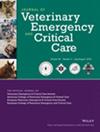Comparison of Two Lung Ultrasound Protocols for Identification and Distribution of B-, I-, and Z-Lines in Clinically Healthy Cats
Abstract
Objective
To investigate the frequency and distribution of B-, I-, and Z-lines in clinically healthy cats and to determine whether there is a difference in frequency and distribution between two different lung ultrasound protocols.
Design
Prospective cross-sectional study from June to September 2022.
Setting
Companion animal referral hospital.
Animals
Sixty-four cats determined to be healthy based on history and physical examination.
Interventions
All cats had point-of-care lung ultrasound performed with frequency of B-, I-, and Z-lines recorded. Findings of a modified Calgary pleura and lung ultrasound (PLUS) protocol (19 sites recorded) and a veterinary Brief Lung Ultrasound Exam (VetBLUE) protocol (nine sites), both including the subxiphoid site, were compared.
Measurements and Main Results
B-lines were identified in 14%–27% of cats depending on the protocol used, with a median of <3 B-lines total per cat, <2 B-lines per hemithorax, and ≤2 positive B-line sites per hemithorax, regardless of the protocol used. The total number of B-, I-, or Z-lines identified was significantly higher for the modified Calgary PLUS compared with VetBLUE. The number of cats with ≥1 B- and I-lines was significantly higher with modified Calgary PLUS compared with VetBLUE, with 17 (26.6%) and 42 (65.6%) versus nine (14.1%) and 34 (53.1%) cats identified, respectively. Z-lines were identified in 62 (96.9%) cats regardless of the protocol used. Three (4.7%) cats had ≥1 B-line at the subxiphoid view.
Conclusions
B-lines were detected in <30%, I-lines in >50%, and Z-lines in >95% of clinically healthy cats regardless of protocol used. B-lines were rarely detected at the subxiphoid view. A significant difference between protocols was found when comparing the percentage of cats with B- and I-lines.


 求助内容:
求助内容: 应助结果提醒方式:
应助结果提醒方式:


